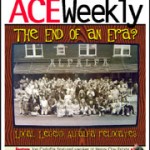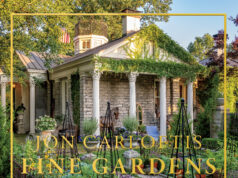BY SARAH TACKETT


Opened in the 70s, when Moosewood (and its subse

When you look at it from the outside, let’s say, Sunday 

There has to be something else that charms people into waiting in line—rain or shine, fire or ice—for pancakes. (The restaurant won the “best pancake” honors in Ace’s Best of Lex readers’ poll so often that the category has been retired.)


Cathy Martin, a longtime employee who, along with her husband, is considered the backbone of the restaurant is happy to have an opportunity to discuss the character of Alfalfa.
Although she seemed terribly busy with the move, she benevolently answered questions between phone calls.
Asked what attracts people to the restaurant, she answered, “The bohemian decor, it’s comfortable and cozy, people just feel comfortable here.” And it’s true.
Maybe it’s the mismatched art on the walls, (paintings next to photographs and children’s drawings), or maybe it’s the potted plants dangling from macramé, juxtaposed against the ‘60s era wood paneling, but there’s no doubt the restaurant is saturated with the familiar.
It’s more like visiting a relative than dining out.
Martin explains, “Regular customers come to see each other, and there’s a lot of visiting from table to table. It’s not just a restaurant, it’s a social gathering place too,” adding, “It’s like a family. [It’s] a really fun place to work, and a wonderful group of customers.”
Asked for a few names of longtime customers who might be willing to share a memory or two, this became patently obvious. Out came her daily planner stuffed with names and numbers—culled to a list of at least twenty people that she felt “really know the place.” (It includes musicians who perform there; artists who exhibit there; authors who’ve read there; and many more.)


Local artist/longtime server, Bill Glasscock, echoed Martin’s sentiments in discussing the place’s charms. Glasscock’s art lines the walls of the restaurant. “I’m real comfortable with having my art here.” He said, explaining that the restaurant attracted artists as not only customers, but as employees.
“Even the dishwasher could be working on their dissertation. That’s like the glue here for us because we can bounce ideas off each other.”
Of course you’d expect that kind of environment with the restaurant being so close to the university. Either eating or working, students, grad-students, and professors all seem to have spent their fair share of lunches in Alfalfa.
This then begs the question if the environment will change along with the location. Asked about the move, Glasscock stated, “It’s difficult. You walk in and a flood of memories comes through. So many people come to see the place and the familiar. They want to buy the planks and stuff.” He said, pointing to the wood lining the walls. “That’s how ingrained we are in the people’s experience.”
And the old Alfalfa is filled with experiences, from brushes with celebrity to infamous FBI investigations.
Glasscock began recalling stories with Martin laughing, knowing the endings before they were finished.
“Tell her the one about the cat.” Martin said. Glasscock grinned wide and laughed, “The day the cat went through the ceiling during lunch? It shows people what we’ve been dealing with for years. Sometimes I would wonder if the ceiling was going to be there when I got there in the morning,” he said, speaking of the structural problems of the restaurant and its leaky ceiling.



“One day a cat was doing what cats do, and fell through. It didn’t quite hit anyone, but landed about here.” He said pointing to a place not too far from our table. (For those concerned about the cat, it’s believed to be in better health than the ceiling.)
Looking at the inside of the old Alfalfa, the walls are crooked and the ceiling curves and dips of its own accord. This produces a whimsical effect, as if the restaurant is defiantly standing up without any appearance of sound support. It seems the entire building is either tired or intoxicated. Although the informal structure parallels the informal dining of the restaurant, the problems have evolved from endearing characteristics to fullblown character flaws.
Really, who wants a cat in their salad niçoise?
When asked about giving up the old building, Glasscock is sanguine, “What are our choices? I think it is going to be a good flip. I have a lot of customers that are excited about the new location because now they can walk there.”


Nobody seems more excited about the move than kitchen manager Paul Nowacki. You can’t blame him. Everyone who passes the rickety screen door to the kitchen on their way to the restaurant entry has to keep their eyes on the sidewalk to maintain their appetite. (Ace editrix proclaimed emphatically, “To their credit, I have never gotten sick there. I just avert my eyes and fall back on my immune system.”)
So it’s with caution that one approaches Nowacki’s lair. For such a crowded space, there were a lot of knives and things on fire. It was also melt-your-tennis-shoes hot.
The kitchen, in fact, was never intended to be a kitchen at all. Artie Howard, one of the original owners, explained that it used to be a barbershop, but they bought the space as the restaurant expanded. For an old barbershop, it has seen its fair share of cooking. When asked, Nowacki stated, “I’ll never miss the kitchen space. It’s a third world kitchen.”
His fellow cook Tom Owens chimed in, “It’s a coffin turned into a sauna with the flames of hell burned in.”
For a third world kitchen, Alfalfa has come a long way with their food.
Howard says they opened with a limited (to say the least) menu. “Originally their were two items on the menu, the special and the basic.”
Howard explained that philosophy of the founding group was quality of food over anything else. This philosophy has turned into tradition.
When asked about the food Nowacki stated, “We use whole foods. Locally grown as much as we can get it.” Although they have kept some of the original recipes like the Hoppin’ John, the menu at Alfalfa has grown far beyond the “special” and the “basic.” Nowacki explains, “Expansion into international foods keeps it exciting for the cooks and

By keeping favorite recipes like the cabbage salad and the bread, the chefs are allowed to be creative about whatever else they cook. Well, as creative you can get in a kitchen where you can’t turn on the griddle and the convection oven at the same time. Nowacki said, “The food will improve dramatically with the space. You’ll be amazed with what we can produce with both a stove and an oven.”
By capturing both the familiar and exotic, the menu continues to draw regular customers with open minds. A group that grows larger every year as you can see in their annual reunion photographs.
Looking back, asked to speculate as to why Alfalfa has been so successful for so long, Howard simply said, “Alfalfa is a restaurant for the people, that’s what it has always been.”
The overall beauty of Alfalfa is that it has developed a community that grows beyond the walls of the building on Limestone. It reaches both into the past and future at the same time, like any family.
Sometimes it’s sad when things change, but it’s time to move on. A building is just a building—the people are what really matters. So suck it up, and go down to the new spot. If you still feel like crying about it, go ahead, at least you’ll be with friends.








